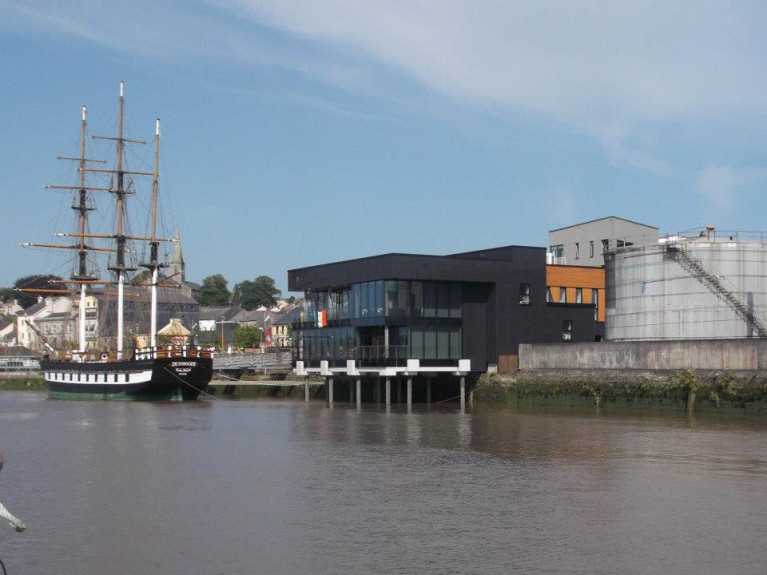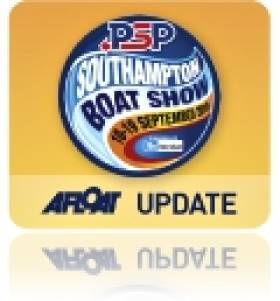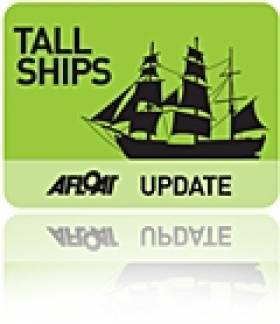Displaying items by tag: Tallship
Dunbrody's Dawn Departure for €700,000 Dry Dock Makeover
The tallship Dunbrody Famine Ship was brought by tug across the Barrow last Monday to New Ross Boat Yard to go into dry dock for three months, during which time she will have extensive works carried out.
Work began on removing the (20 year old replica) vessel and the gangways from 5 a.m.
A crane was used to lift the gangway onto a truck and to disengage the rollers from the piles, prior to a tug bringing her safely across the river on a high tide, where she slipped into dry dock at 8 a.m.
Preparatory work was carried out over the previous fortnight.
Dunbrody Experience Visitor Centre CEO Sean Connick thanked local boat owners and New Ross Boat Yard staff for their work, along with Tom Byrne and John Dimond.
Further reading from the New Ross Standard here.
‘Most Beautiful Ship’ In the World Visited Dublin Port
Italian tallship Amerigo Vespucci, once described by US sailors as the most beautiful in the world, (on Monday) docked at Dublin Port.
As The Irish Times reported, Amerigo Vespucci is a training vessel for Italian Navy cadets who sail for three months at the end of their first year at the Livorno Naval Academy. The period on the ship is intended to give the trainees the skills and world experience needed to become successful mariners.
They spend three or four days in each town or city in which they moor. While in Dublin, they plan on visiting Trinity College, the Guinness Storehouse and the Google building. The trainees sleep in hammocks while on board and there are four rooms below deck for the male cadets, and one for female cadets.
Federica Bellina (19), one of the 133 cadets on the ship, among 35 women, said she had wanted to join the navy since she was very young.
“We are able to open the sails and use the wind in order to navigate,” said Ms Bellina. “It’s a wonderful experience because we are on the masts and we can see the ocean, we can see the sea and we are an active part of the ship.”
They use “nautical observation” to determine the location of the ship relative to the stars and sun. They take care of the ships, train physically — often stopping to row in boats — and monitor the sea for targets or other ships.
Ms Bellina is training as a coast guard, which will see her study for five years in the academy.
For more on the recent visit click here as Afloat adds this morning the tallship departed the capital and is next bound for Bergen in Norway.
Mexican Navy Tall Ship Sails into Dublin
#mexicantallship – Dublin Port Company and the Mexican Embassy in Dublin have welcomed one of the world's most magnificent Tall Ships, the 1,800 tonnes and 270 foot long Cuauhtémoc – that had been at anchor in Dublin Bay since Monday – sailed into Dublin city centre this morning for a five day visit to the capital.
The spectacular vessel was met by Dublin Port's tugs Shackleton and Beaufort in a ceremonial escort to mark the ship's arrival, before docking at 10am on Sir John Rogerson's Quay.
As Afloat previously reported last week the windjammer commanded by Captain Pedro Mata, the Cuauhtémoc is a sail training vessel of the Mexican Navy which travels around the world carrying a message of friendship and goodwill. She arrived in Dublin with 225 men and women sailors on board - including trainees of different nationalities - who will participate in a five-day programme of engagements in the capital as part of the 40th anniversary celebration of the establishment of diplomatic relations between Ireland and Mexico.
Highlights of the itinerary include an accompanied tour of the city for crew, a visit to the vessel by President Michael D. Higgins and his wife Sabina Higgins on Sunday, and a special performance by 'The Buena Vibra Latin Jazz Trio with the Royal Irish Academy of Music Percussion Ensemble' on board, as well as the San Patricio Mariachi Band.
Dubliners and visitors to the city hoping to get a closer insight into life on board this magnificent vessel will be able to visit for free while she is berthed at Sir John Rogerson's Quay. Opening times to the public are Wednesday 17th – Saturday 20th June between 10.00 and 19.00, and on Sunday 21st June from 10.00 to 15.00. During her last visit to Dublin as part of the Tall Ship Races 2012, the Cuauhtémoc welcomed over 23,000 visitors on board.
Built in the Celaya shipyards in Bilbao, Spain, the Cuauhtémoc was launched in July 1982. She was the last of four windjammers built by Bilbao shipyards and is named after the last Aztec emperor who was imprisoned and executed by the conquistador, Herman Cortes, in 1525. This will be her fourth visit to Irish waters.
Eamonn O'Reilly, Chief Executive of Dublin Port Company, said: "Dublin Port Company is delighted to welcome Cuauhtémoc and her entire crew to Dublin for a very special visit in a significant year for Mexican-Irish relations. Her visit serves as an important reminder of our cultural bond and trading links that have grown from strength to strength over the past 40 years. I would encourage everyone in the city to show the Cuauhtémoc a warm Irish welcome during her stay. It's a fantastic opportunity to explore this magnificent vessel up close and experience first-hand Mexican maritime culture on our doorstep."
The Ambassador of Mexico to Ireland, H.E. Carlos Garcia de Alba said: "2015 marks the 40th anniversary of the establishment of diplomatic relations between Ireland and Mexico. This important milestone in our shared history affords both Mexico and Ireland the opportunity to showcase trade, academic and investment partnerships and to share in artistic and cultural exchanges between our countries. The arrival to Dublin of the Mexican Navy's Tall Ship Cuauhtémoc is just one of the many events to take place that reaffirms the commitment to strengthen the excellent ties of friendship and co-operation between our nations."
Tallship Phoenix at the Southampton Boat Show
#southamptonboatshow – The PSP Southampton Boat Show has almost 150 boats on display and accompanied by larger visiting vessels, among them the attraction of the tallship Phoenix.
The two-masted brig Pheonix welcomes those on board during the show which continues to next Sunday 21 September.
Phoenix has starred in countless shows and films including: Alice In Wonderland, Clash of the Titans, Cloud Atlas, Dr. Who and the Count Of Monte Cristo.
She is berthed in one of Europe's largest purpose-built marinas with over 2km of pontoons. So make sure you get on board the 112ft brig and explore the three decks of this vessel that could be straight out of the times of Blackbeard and his pirates!
A Weekend to Explore the 'Bounty'
The Cork-berthed replica HMS Bounty, the purpose built movie prop tallship used in the 1962 MGM studies film release of 'Mutiny and the Bounty' starring Marlon Brando, will be open to visitors from tomorrow, writes Jehan Ashmore.
The famous tall ship is to open to the public between (11am-6pm) and these times also apply to the Saturday and Sunday. Tours on board the Bounty are self-guided with crew assistance. Admission charges are €10 for adults and children €5, children under four years go free.
The Bounty is berthed at Albert Quay which faces opposite the Cork City Marina on the south quays of the city-centre.
The public can explore her "tween" deck 8' foot ceilings, this made it easier for the film crew and their equipment to access.
As a result, Bounty has been hired by filmcrews for the making of 'Treasure Island', 'Yellowbeard', 'Sponge Bob, Square Pants, the Movie' and 'Pirates of the Caribbean - Dead Man's Chest'. In addition to commercial movies, Bounty has also been the stage for many documentaries.
To compare the differences between the replica and the original 18th century built 'Bounty' click HERE.
Dubin's Lord Mayor opened a Tall Ship and Youth Sail Training Workshop with an agenda to seek a solution to the current Irish Sail Training impasse caused by the loss of sailing's Asgard II and Lord Rank.
Over 70 delegtes including many of the 'top brass' of the Irish Tall Ship commuunity attended the meeting held at the offices of Dublin Port Company on Saturday (26th March). The meeting inlcuded members of Coiste an Asgard, port companies, education, tourism and other sailing interests.
The meeting was formally opened by Dublin Lord Mayor and Port Admiral, Gerry Breen who introduced the chairman Lord Glentoran and the Facilitator Michael Counahan.

From (Left to right) Seamus McLoughlin, Dublin Port Head of Operations, Enda Connellan, Chairman Tall Ships Dublin 2012, Des Whelan, Chair Tall Ships Waterford 2011, Lord Glentoran (Robin Dixon) Chair Tall Ships Belfast 1992, Dr. Gerard O'Hare, Chair Tall Ships Belfast 2009, Ted Crosbie, Tall Ships Cork and Enda O'Coineen, LetsdoitGlobal.
Des Whelan gave an excellent talk and presentation on Tall Ships Waterford which was followed by a discussion on the massive economic benefits of bringing Tall Ships Festivals To Dublin, Cork and Belfast. Chairman of Tall Ships Dublin 2012 Enda Connellan and Ted Crosbie of Tall Ships Cork and Dr. Gerard O' Hare of Tall Ships Belfast discussed the incredible success stories from their respective ports festivals.
Several presentations and discussions followed regarding the role of Tall Ships in Sail Training, the connection between a vessel for Ireland and running events here. The question of who are the stakeholders and how can benefits be quantified was also discussed.
The meeting was hosted by Dublin Port Company who provided a warm welcome, excellent facilities, refreshments and a wonderful lunch with senior management attending to everyone's needs.
After lunch there were further discussions on what is the most suitable vessel, who should run the organisation and what would work best for Ireland.
Jimmy Tyrrell gave a short, eloquent and emotional account of Asgard II and the realisation of his father's dream which was fulfilled beyond all expectation by that legendary vessel and those who were privileged to sail on her. He affirmed his own belief that the way forward was with an All-Ireland Tall Ship and even suggested that she be called Spirit of Ireland. There were other suggestions for a name inlcuding 'Ireland's Call'.
A view was also expressed that politics and religion have no place in Sail Trail Training and the future lay in an All-Ireland Commercial/Charitable Trust Venture.
The prohibitive nature of current legislation and the total lack of awareness of the maritime sector by the Government was mentioned several times.
Ocean Youth Club NI provided four young sail trainees to address the gathering on the benefits of Sail Training from their perspective and representatives from education, tourism Tall Ships International and "Association Of Tall Ships Organisations" also contributed.
The general consensus was the need to develop and promote, as a matter of urgency, a plan for a Tall Ship For Ireland linking Youth, Maritime Education, Business and Tourism.
Another workshop will be held in Belfast in April and the collective input of both meetings will be considered going forward.
A Tall Order for Ireland? HERE
Regular updates on Irish Tall Ship sailing news HERE
More on Asgard II HERE



































































